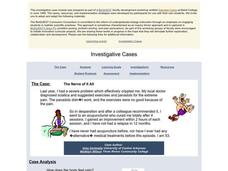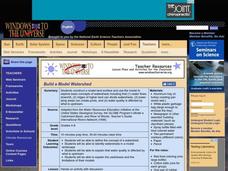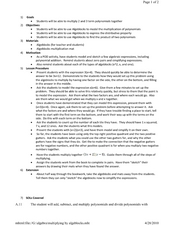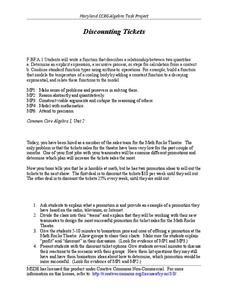Illustrative Mathematics
Dividing by One-Half
Understanding when to divide by two or one-half can be confusing. Here is an activity that gives four different scenarios. It is up to your number crunchers to decide if they divide by two or one-half. The easiest way to approach the...
EngageNY
The Division of Polynomials
Build a true understanding of division of polynomials. Learners use their knowledge of multiplying polynomials to create an algorithm to divide polynomials. The area model of multiplication becomes the reverse tabular method of division.
Illustrative Mathematics
Dan’s Division Strategy
Can Dan make a conjecture about dividing fractions with the same denominators? That is what your scholars are to determine. They must show that if the statement is true, they understand how the quantities were determined, and how the...
Curated OER
Build a Model Watershed
Collaborative earth science groups create a working model of a watershed. Once it has been developed, you come along and introduce a change in land use, impacting the quality of water throughout their watershed. Model making is an...
Illustrative Mathematics
Fractions and Rectangles
Visual models are excellent teaching tools when explaining equivalent fractions. Looking at a rectangle cut into twelfths, students first identify the shaded fraction, and then explain whether the fraction is equal to one-fourth....
Illustrative Mathematics
How Many Containers in One Cup / Cups in One Container?
The object is to model fraction division by asking “How many are in one group?” It is a difficult concept to understand, but developing the model that shows one cup to a certain amount of container or one container to a certain amount of...
EngageNY
The Long Division Algorithm
Two methods are always better than one! The eighth installment in this series asks pupils to convert decimals to fractions using two approaches. Individuals first use the more traditional approach of long division and then use reverse...
Illustrative Mathematics
How Many Servings of Oatmeal?
Here is another way to illustrate division of a whole number by a unit fraction. In this case, the problem is asking if there are so many servings per cup, how many servings are in a package of multiple cups. Learners are to model their...
EngageNY
Multiplying and Dividing Rational Expressions
Five out of four people have trouble with fractions! After comparing simplifying fractions to simplifying rational expressions, pupils use the same principles to multiply and divide rational expressions.
NTTI
Hey Good Lookin', Whatchya Got Cookin'?
What better way to explore working with fractions then by using them when cooking? In this lesson, students use video, the Internet, and real world, hands-on learning activities to enhance their understanding of multiplying and dividing...
Curated OER
Cell Size and Division or How Big Would You Want To Be if You Were a Cell?
Learners investigate why cells divide. In this cell size lesson plan, students observe how far a solution travels into 3 different size model cells of agar. They answer questions about the most effect movement of "nutrients" into the...
Illustrative Mathematics
Banana Pudding
Making banana pudding despite misplacing your one-cup measuring cup is easy as long as you can find your quarter-cup measuring cup! This real-life activity provides a good opportunity for learners to interpret division of a whole number...
Illustrative Mathematics
Running to School, Variation 2
Rose's commute to school is a fractional distance. After she runs part of the way, your class needs to determine what fractional distance she ran. This problem explores fraction operations through modeling and computation. The...
Curated OER
Students Multiply Polynomials
Factor polynomial functions that have two and three terms. Using Algeblocks, your class will create models to show their understanding of these concepts.
LABScI
DNA Structure: Gumdrop Modeling
DNA molecules hold the secrets that make us unique. The fourth of 12 lessons explores the structure of DNA by building candy models. After building the models, young scientists break their models to begin the process of DNA replication....
Curated OER
Dividing by 4's
Third graders explore math functions by completing problem solving activities. In this division lesson, 3rd graders utilize the division strategies acquired earlier to divide multiple digit numbers by 4's. Students complete problems on...
EngageNY
The Multiplication of Polynomials
If you can multiply multi-digit integers, you can multiply polynomials. Learners use an area model to compare multiplying numbers to multiplying polynomials. They progress to using the distributive property.
Curated OER
Cell Division and Mitosis
Students identify each phase of mitosis and the main characteristics of each. Students prepare a microscope slide with onion root tip. Students observe the cell division occurring in the cells and label the mitosis phases observed.
Curated OER
Modeling Equations with Bars
Young scholars model linear equations using bars. In this algebra lesson, students solve two steps linear equations through modeling of division, addition and multiplication. They use manipulative to solve equations.
Curated OER
The Color Spectrum: How Does it Work?
Create models of the infrared, visible, and ultraviolet portions of the electromagnetic spectrum. Working in small groups, your class can investigate metric conversions calculations. They will find the length of the waves in nanometers,...
02 x 02 Worksheets
Inverse Variation
Discover an inverse variation pattern. A simple lesson plan design allows learners to explore a nonlinear pattern. Scholars analyze a distance, speed, and time relationship through tables and graphs. Eventually, they write an equation to...
Howard County Schools
Discounting Tickets
A boss who can't do math? Oh, no! Young entrepreneurs use linear and exponential models to determine which discount will yield the most profit on ticket sales.
Curated OER
Ocean Floor Model
Students construct a simulated model of the ocean floor in a shoe box. They determine that the floor of the ocean is composed of hills, plains, ridges, trenches, and sea mounts. They draw out a plan for their ocean floor which includes...
Curated OER
Cell Division: Frog Egg Division Observation and Modeling
Students create and test a hypothesis about cell division. After observation of Frog Egg cell division, students write obervations and refine process and hypothesis. The use of scientific method, group work and inquiry are fostered by...

























